THE AVIATION SAFETY
VerifiedAdded on 2022/09/07
|16
|4536
|19
AI Summary
Contribute Materials
Your contribution can guide someone’s learning journey. Share your
documents today.
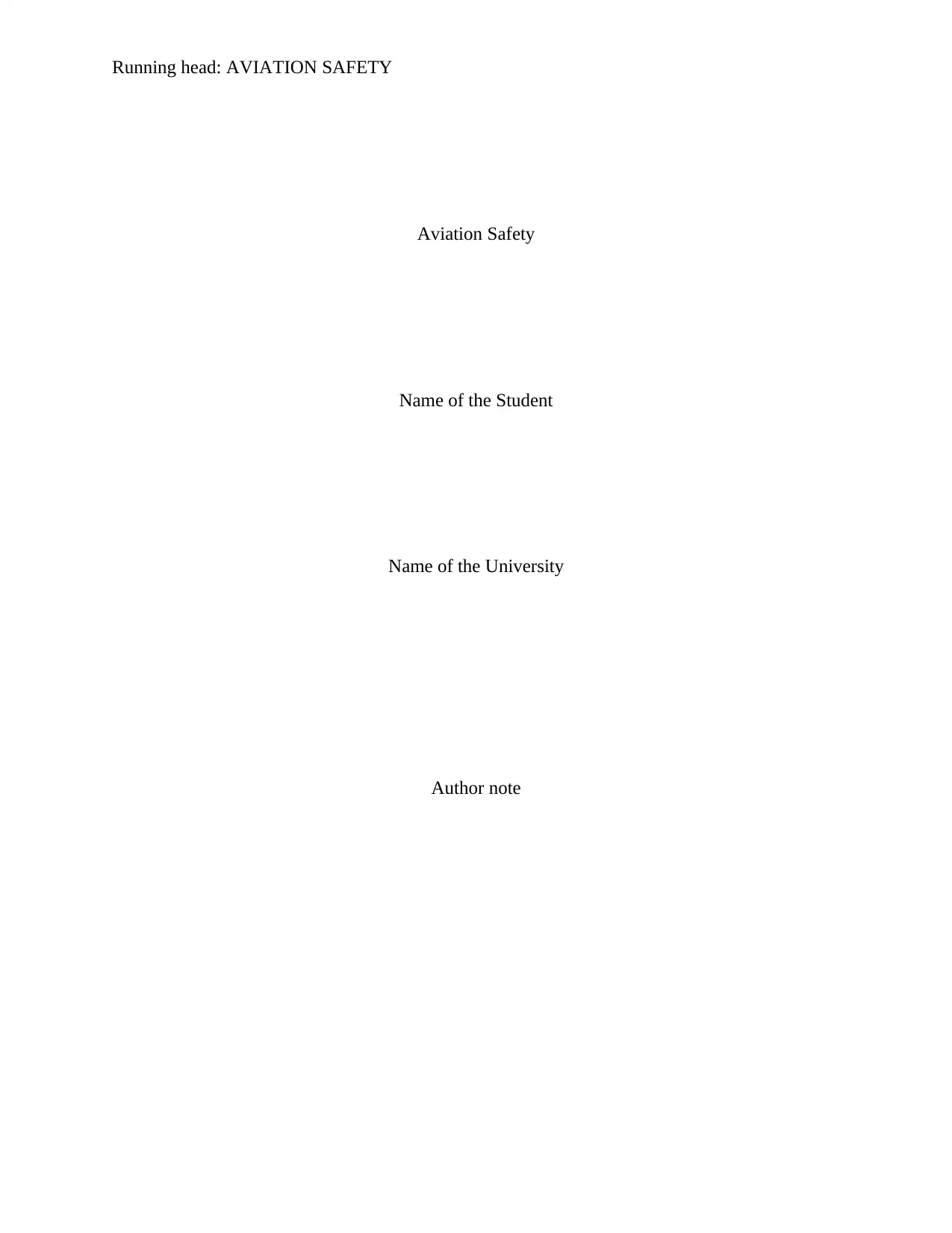
Running head: AVIATION SAFETY
Aviation Safety
Name of the Student
Name of the University
Author note
Aviation Safety
Name of the Student
Name of the University
Author note
Secure Best Marks with AI Grader
Need help grading? Try our AI Grader for instant feedback on your assignments.
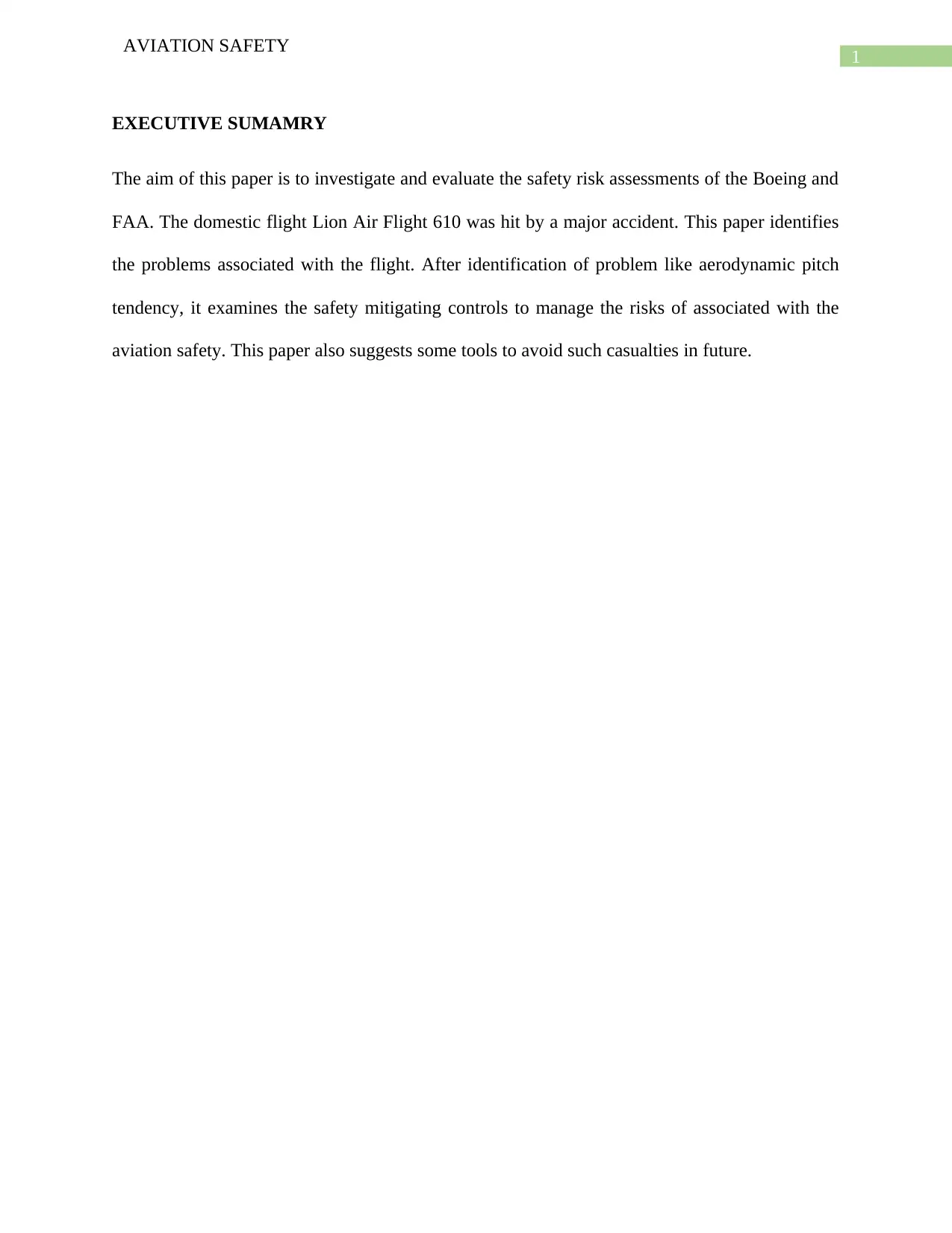
1
AVIATION SAFETY
EXECUTIVE SUMAMRY
The aim of this paper is to investigate and evaluate the safety risk assessments of the Boeing and
FAA. The domestic flight Lion Air Flight 610 was hit by a major accident. This paper identifies
the problems associated with the flight. After identification of problem like aerodynamic pitch
tendency, it examines the safety mitigating controls to manage the risks of associated with the
aviation safety. This paper also suggests some tools to avoid such casualties in future.
AVIATION SAFETY
EXECUTIVE SUMAMRY
The aim of this paper is to investigate and evaluate the safety risk assessments of the Boeing and
FAA. The domestic flight Lion Air Flight 610 was hit by a major accident. This paper identifies
the problems associated with the flight. After identification of problem like aerodynamic pitch
tendency, it examines the safety mitigating controls to manage the risks of associated with the
aviation safety. This paper also suggests some tools to avoid such casualties in future.
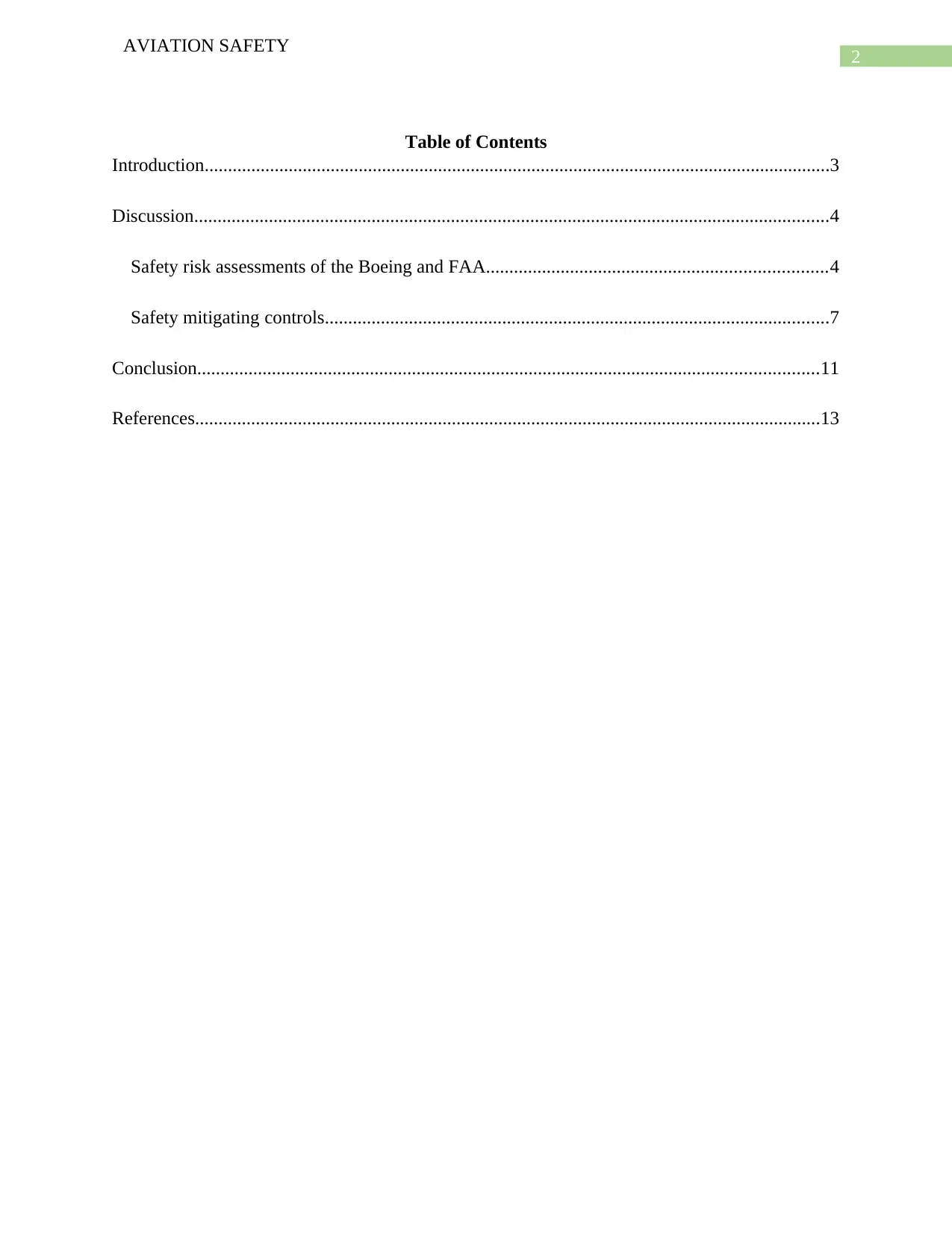
2
AVIATION SAFETY
Table of Contents
Introduction......................................................................................................................................3
Discussion........................................................................................................................................4
Safety risk assessments of the Boeing and FAA.........................................................................4
Safety mitigating controls............................................................................................................7
Conclusion.....................................................................................................................................11
References......................................................................................................................................13
AVIATION SAFETY
Table of Contents
Introduction......................................................................................................................................3
Discussion........................................................................................................................................4
Safety risk assessments of the Boeing and FAA.........................................................................4
Safety mitigating controls............................................................................................................7
Conclusion.....................................................................................................................................11
References......................................................................................................................................13
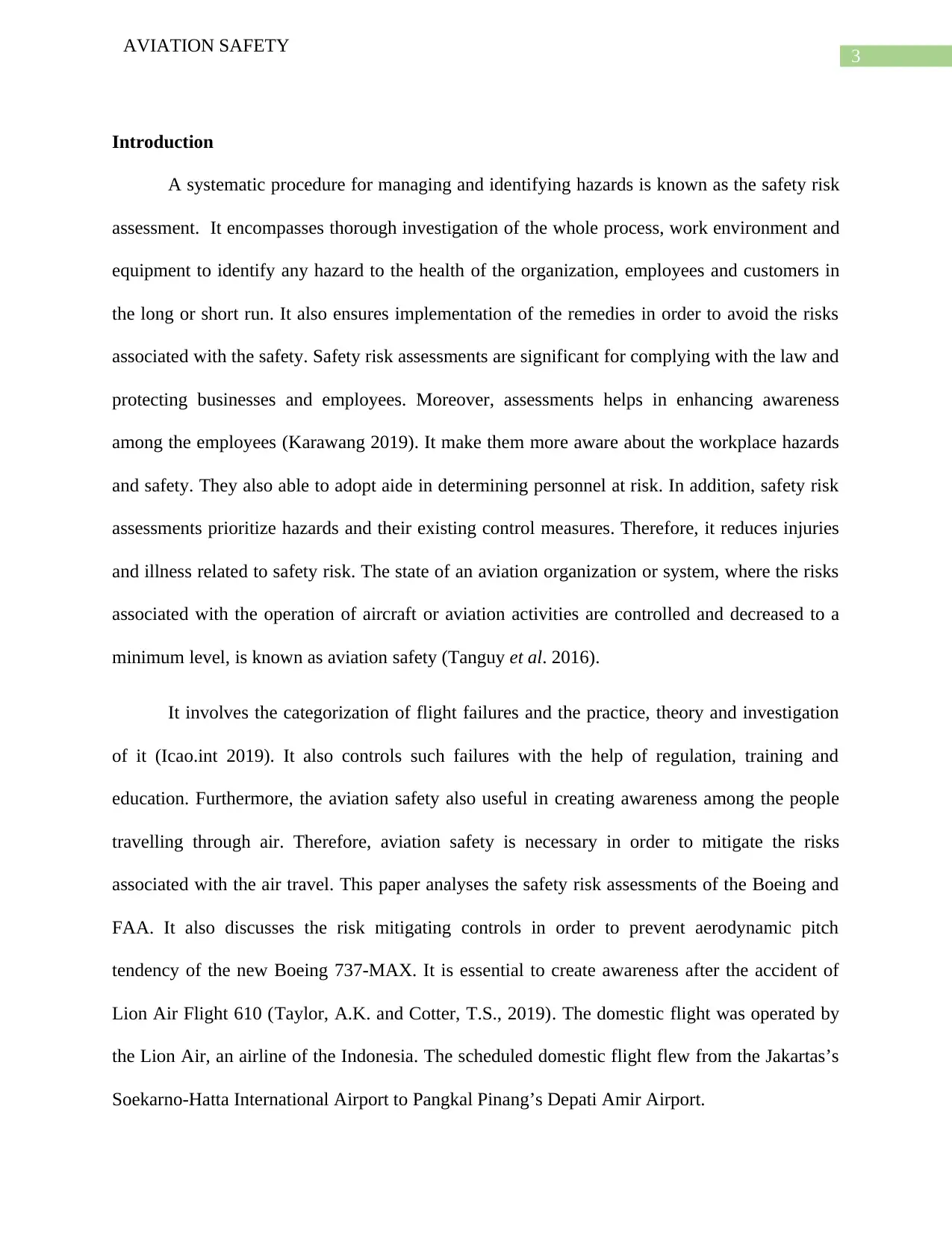
3
AVIATION SAFETY
Introduction
A systematic procedure for managing and identifying hazards is known as the safety risk
assessment. It encompasses thorough investigation of the whole process, work environment and
equipment to identify any hazard to the health of the organization, employees and customers in
the long or short run. It also ensures implementation of the remedies in order to avoid the risks
associated with the safety. Safety risk assessments are significant for complying with the law and
protecting businesses and employees. Moreover, assessments helps in enhancing awareness
among the employees (Karawang 2019). It make them more aware about the workplace hazards
and safety. They also able to adopt aide in determining personnel at risk. In addition, safety risk
assessments prioritize hazards and their existing control measures. Therefore, it reduces injuries
and illness related to safety risk. The state of an aviation organization or system, where the risks
associated with the operation of aircraft or aviation activities are controlled and decreased to a
minimum level, is known as aviation safety (Tanguy et al. 2016).
It involves the categorization of flight failures and the practice, theory and investigation
of it (Icao.int 2019). It also controls such failures with the help of regulation, training and
education. Furthermore, the aviation safety also useful in creating awareness among the people
travelling through air. Therefore, aviation safety is necessary in order to mitigate the risks
associated with the air travel. This paper analyses the safety risk assessments of the Boeing and
FAA. It also discusses the risk mitigating controls in order to prevent aerodynamic pitch
tendency of the new Boeing 737-MAX. It is essential to create awareness after the accident of
Lion Air Flight 610 (Taylor, A.K. and Cotter, T.S., 2019). The domestic flight was operated by
the Lion Air, an airline of the Indonesia. The scheduled domestic flight flew from the Jakartas’s
Soekarno-Hatta International Airport to Pangkal Pinang’s Depati Amir Airport.
AVIATION SAFETY
Introduction
A systematic procedure for managing and identifying hazards is known as the safety risk
assessment. It encompasses thorough investigation of the whole process, work environment and
equipment to identify any hazard to the health of the organization, employees and customers in
the long or short run. It also ensures implementation of the remedies in order to avoid the risks
associated with the safety. Safety risk assessments are significant for complying with the law and
protecting businesses and employees. Moreover, assessments helps in enhancing awareness
among the employees (Karawang 2019). It make them more aware about the workplace hazards
and safety. They also able to adopt aide in determining personnel at risk. In addition, safety risk
assessments prioritize hazards and their existing control measures. Therefore, it reduces injuries
and illness related to safety risk. The state of an aviation organization or system, where the risks
associated with the operation of aircraft or aviation activities are controlled and decreased to a
minimum level, is known as aviation safety (Tanguy et al. 2016).
It involves the categorization of flight failures and the practice, theory and investigation
of it (Icao.int 2019). It also controls such failures with the help of regulation, training and
education. Furthermore, the aviation safety also useful in creating awareness among the people
travelling through air. Therefore, aviation safety is necessary in order to mitigate the risks
associated with the air travel. This paper analyses the safety risk assessments of the Boeing and
FAA. It also discusses the risk mitigating controls in order to prevent aerodynamic pitch
tendency of the new Boeing 737-MAX. It is essential to create awareness after the accident of
Lion Air Flight 610 (Taylor, A.K. and Cotter, T.S., 2019). The domestic flight was operated by
the Lion Air, an airline of the Indonesia. The scheduled domestic flight flew from the Jakartas’s
Soekarno-Hatta International Airport to Pangkal Pinang’s Depati Amir Airport.
Secure Best Marks with AI Grader
Need help grading? Try our AI Grader for instant feedback on your assignments.
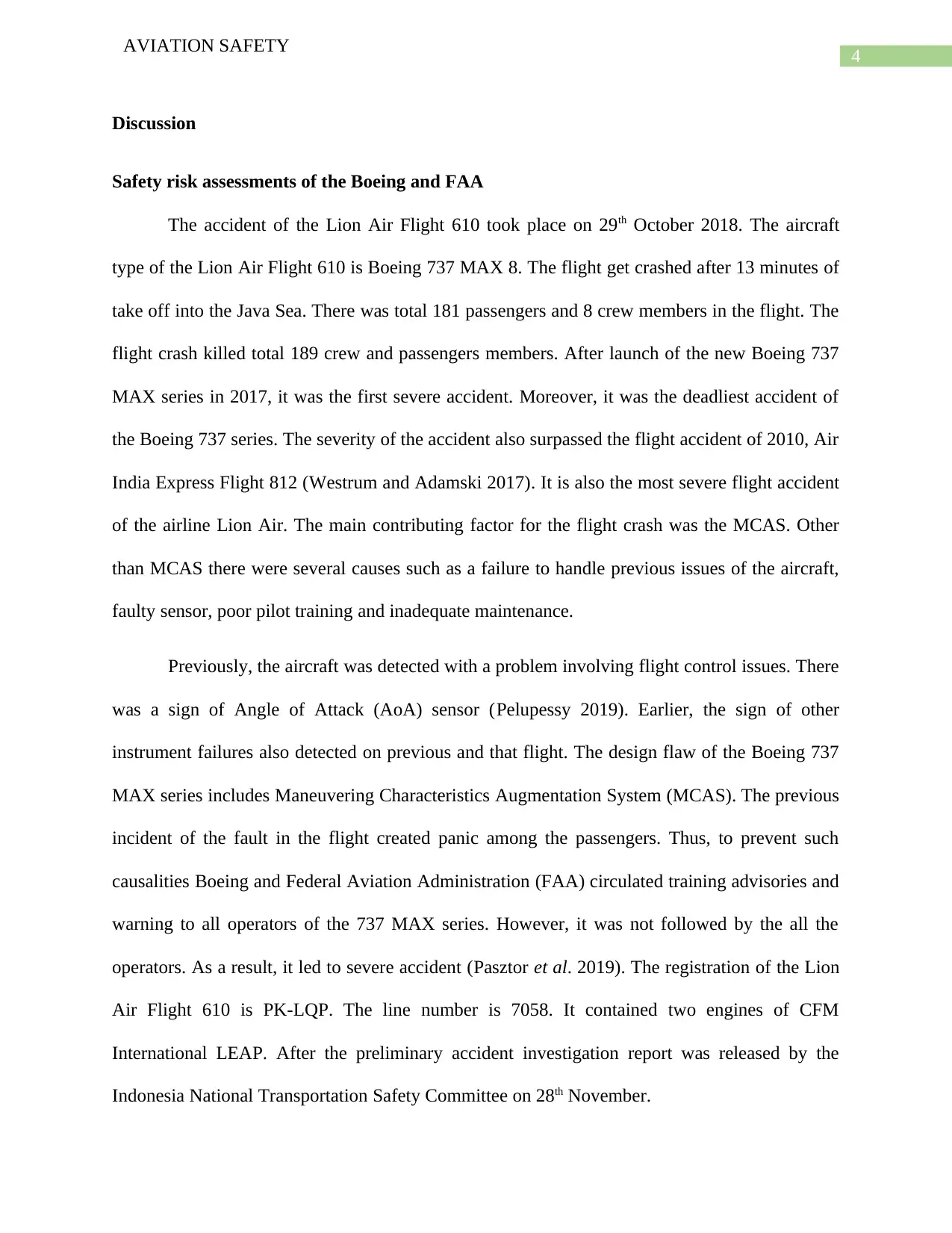
4
AVIATION SAFETY
Discussion
Safety risk assessments of the Boeing and FAA
The accident of the Lion Air Flight 610 took place on 29th October 2018. The aircraft
type of the Lion Air Flight 610 is Boeing 737 MAX 8. The flight get crashed after 13 minutes of
take off into the Java Sea. There was total 181 passengers and 8 crew members in the flight. The
flight crash killed total 189 crew and passengers members. After launch of the new Boeing 737
MAX series in 2017, it was the first severe accident. Moreover, it was the deadliest accident of
the Boeing 737 series. The severity of the accident also surpassed the flight accident of 2010, Air
India Express Flight 812 (Westrum and Adamski 2017). It is also the most severe flight accident
of the airline Lion Air. The main contributing factor for the flight crash was the MCAS. Other
than MCAS there were several causes such as a failure to handle previous issues of the aircraft,
faulty sensor, poor pilot training and inadequate maintenance.
Previously, the aircraft was detected with a problem involving flight control issues. There
was a sign of Angle of Attack (AoA) sensor (Pelupessy 2019). Earlier, the sign of other
instrument failures also detected on previous and that flight. The design flaw of the Boeing 737
MAX series includes Maneuvering Characteristics Augmentation System (MCAS). The previous
incident of the fault in the flight created panic among the passengers. Thus, to prevent such
causalities Boeing and Federal Aviation Administration (FAA) circulated training advisories and
warning to all operators of the 737 MAX series. However, it was not followed by the all the
operators. As a result, it led to severe accident (Pasztor et al. 2019). The registration of the Lion
Air Flight 610 is PK-LQP. The line number is 7058. It contained two engines of CFM
International LEAP. After the preliminary accident investigation report was released by the
Indonesia National Transportation Safety Committee on 28th November.
AVIATION SAFETY
Discussion
Safety risk assessments of the Boeing and FAA
The accident of the Lion Air Flight 610 took place on 29th October 2018. The aircraft
type of the Lion Air Flight 610 is Boeing 737 MAX 8. The flight get crashed after 13 minutes of
take off into the Java Sea. There was total 181 passengers and 8 crew members in the flight. The
flight crash killed total 189 crew and passengers members. After launch of the new Boeing 737
MAX series in 2017, it was the first severe accident. Moreover, it was the deadliest accident of
the Boeing 737 series. The severity of the accident also surpassed the flight accident of 2010, Air
India Express Flight 812 (Westrum and Adamski 2017). It is also the most severe flight accident
of the airline Lion Air. The main contributing factor for the flight crash was the MCAS. Other
than MCAS there were several causes such as a failure to handle previous issues of the aircraft,
faulty sensor, poor pilot training and inadequate maintenance.
Previously, the aircraft was detected with a problem involving flight control issues. There
was a sign of Angle of Attack (AoA) sensor (Pelupessy 2019). Earlier, the sign of other
instrument failures also detected on previous and that flight. The design flaw of the Boeing 737
MAX series includes Maneuvering Characteristics Augmentation System (MCAS). The previous
incident of the fault in the flight created panic among the passengers. Thus, to prevent such
causalities Boeing and Federal Aviation Administration (FAA) circulated training advisories and
warning to all operators of the 737 MAX series. However, it was not followed by the all the
operators. As a result, it led to severe accident (Pasztor et al. 2019). The registration of the Lion
Air Flight 610 is PK-LQP. The line number is 7058. It contained two engines of CFM
International LEAP. After the preliminary accident investigation report was released by the
Indonesia National Transportation Safety Committee on 28th November.
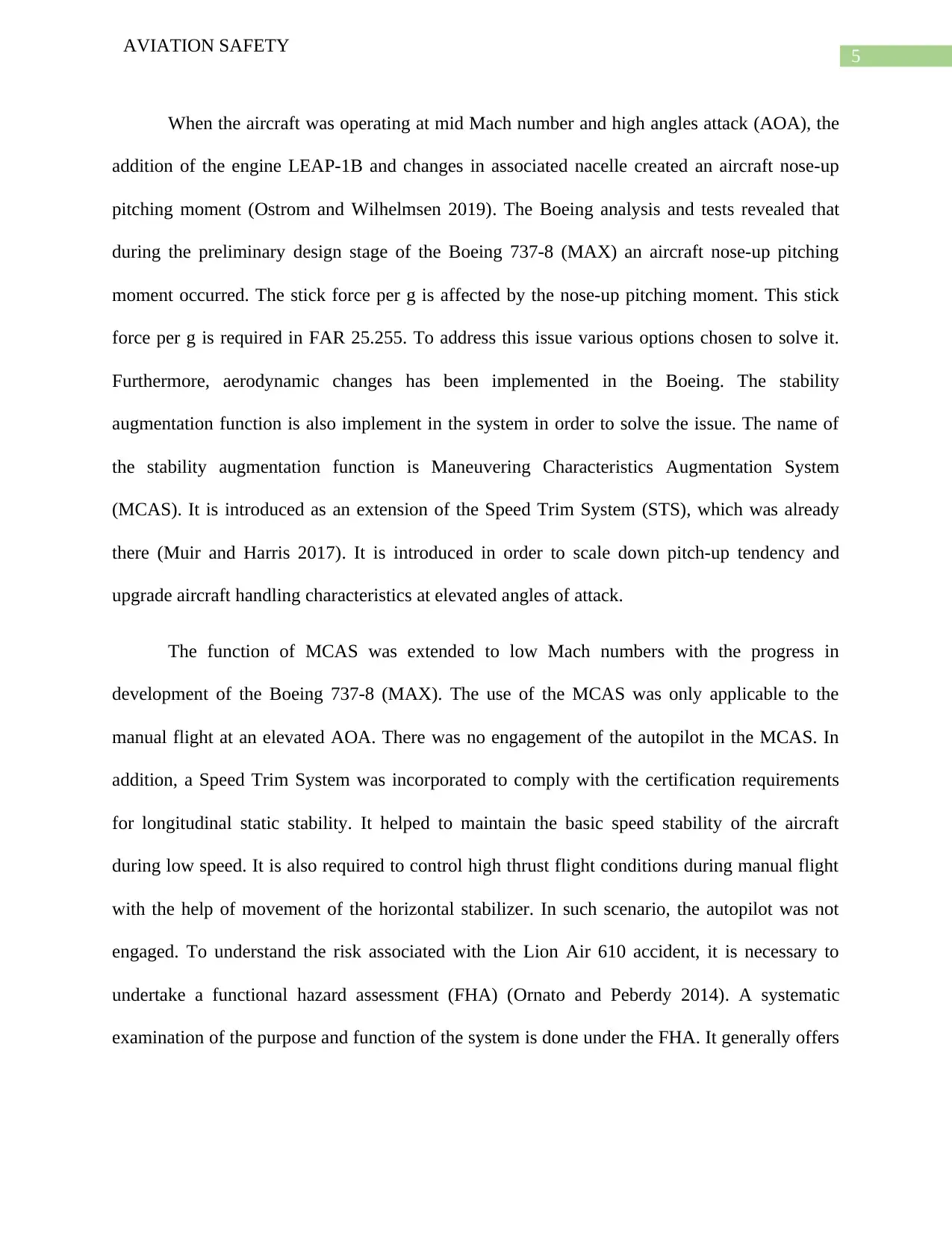
5
AVIATION SAFETY
When the aircraft was operating at mid Mach number and high angles attack (AOA), the
addition of the engine LEAP-1B and changes in associated nacelle created an aircraft nose-up
pitching moment (Ostrom and Wilhelmsen 2019). The Boeing analysis and tests revealed that
during the preliminary design stage of the Boeing 737-8 (MAX) an aircraft nose-up pitching
moment occurred. The stick force per g is affected by the nose-up pitching moment. This stick
force per g is required in FAR 25.255. To address this issue various options chosen to solve it.
Furthermore, aerodynamic changes has been implemented in the Boeing. The stability
augmentation function is also implement in the system in order to solve the issue. The name of
the stability augmentation function is Maneuvering Characteristics Augmentation System
(MCAS). It is introduced as an extension of the Speed Trim System (STS), which was already
there (Muir and Harris 2017). It is introduced in order to scale down pitch-up tendency and
upgrade aircraft handling characteristics at elevated angles of attack.
The function of MCAS was extended to low Mach numbers with the progress in
development of the Boeing 737-8 (MAX). The use of the MCAS was only applicable to the
manual flight at an elevated AOA. There was no engagement of the autopilot in the MCAS. In
addition, a Speed Trim System was incorporated to comply with the certification requirements
for longitudinal static stability. It helped to maintain the basic speed stability of the aircraft
during low speed. It is also required to control high thrust flight conditions during manual flight
with the help of movement of the horizontal stabilizer. In such scenario, the autopilot was not
engaged. To understand the risk associated with the Lion Air 610 accident, it is necessary to
undertake a functional hazard assessment (FHA) (Ornato and Peberdy 2014). A systematic
examination of the purpose and function of the system is done under the FHA. It generally offers
AVIATION SAFETY
When the aircraft was operating at mid Mach number and high angles attack (AOA), the
addition of the engine LEAP-1B and changes in associated nacelle created an aircraft nose-up
pitching moment (Ostrom and Wilhelmsen 2019). The Boeing analysis and tests revealed that
during the preliminary design stage of the Boeing 737-8 (MAX) an aircraft nose-up pitching
moment occurred. The stick force per g is affected by the nose-up pitching moment. This stick
force per g is required in FAR 25.255. To address this issue various options chosen to solve it.
Furthermore, aerodynamic changes has been implemented in the Boeing. The stability
augmentation function is also implement in the system in order to solve the issue. The name of
the stability augmentation function is Maneuvering Characteristics Augmentation System
(MCAS). It is introduced as an extension of the Speed Trim System (STS), which was already
there (Muir and Harris 2017). It is introduced in order to scale down pitch-up tendency and
upgrade aircraft handling characteristics at elevated angles of attack.
The function of MCAS was extended to low Mach numbers with the progress in
development of the Boeing 737-8 (MAX). The use of the MCAS was only applicable to the
manual flight at an elevated AOA. There was no engagement of the autopilot in the MCAS. In
addition, a Speed Trim System was incorporated to comply with the certification requirements
for longitudinal static stability. It helped to maintain the basic speed stability of the aircraft
during low speed. It is also required to control high thrust flight conditions during manual flight
with the help of movement of the horizontal stabilizer. In such scenario, the autopilot was not
engaged. To understand the risk associated with the Lion Air 610 accident, it is necessary to
undertake a functional hazard assessment (FHA) (Ornato and Peberdy 2014). A systematic
examination of the purpose and function of the system is done under the FHA. It generally offers
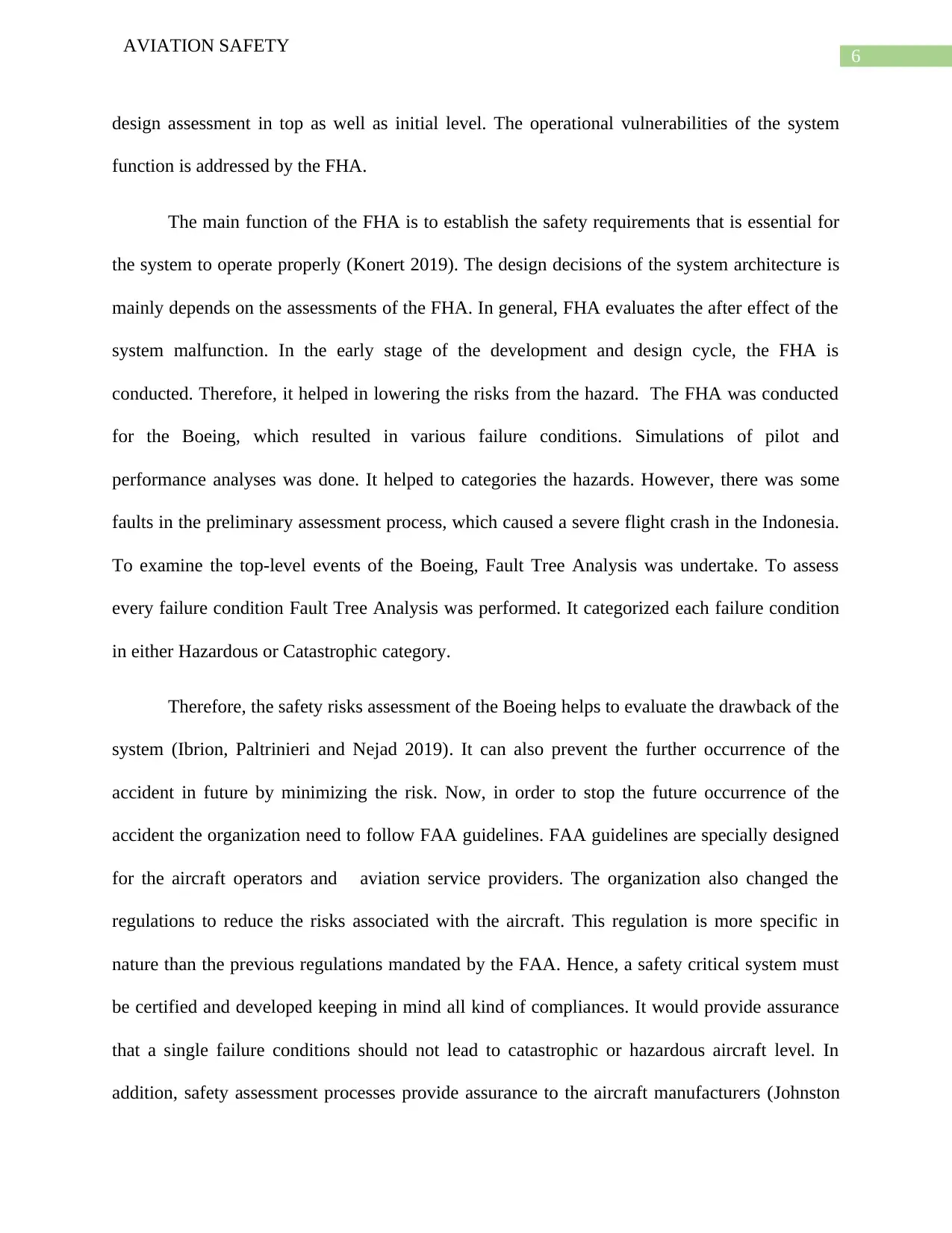
6
AVIATION SAFETY
design assessment in top as well as initial level. The operational vulnerabilities of the system
function is addressed by the FHA.
The main function of the FHA is to establish the safety requirements that is essential for
the system to operate properly (Konert 2019). The design decisions of the system architecture is
mainly depends on the assessments of the FHA. In general, FHA evaluates the after effect of the
system malfunction. In the early stage of the development and design cycle, the FHA is
conducted. Therefore, it helped in lowering the risks from the hazard. The FHA was conducted
for the Boeing, which resulted in various failure conditions. Simulations of pilot and
performance analyses was done. It helped to categories the hazards. However, there was some
faults in the preliminary assessment process, which caused a severe flight crash in the Indonesia.
To examine the top-level events of the Boeing, Fault Tree Analysis was undertake. To assess
every failure condition Fault Tree Analysis was performed. It categorized each failure condition
in either Hazardous or Catastrophic category.
Therefore, the safety risks assessment of the Boeing helps to evaluate the drawback of the
system (Ibrion, Paltrinieri and Nejad 2019). It can also prevent the further occurrence of the
accident in future by minimizing the risk. Now, in order to stop the future occurrence of the
accident the organization need to follow FAA guidelines. FAA guidelines are specially designed
for the aircraft operators and aviation service providers. The organization also changed the
regulations to reduce the risks associated with the aircraft. This regulation is more specific in
nature than the previous regulations mandated by the FAA. Hence, a safety critical system must
be certified and developed keeping in mind all kind of compliances. It would provide assurance
that a single failure conditions should not lead to catastrophic or hazardous aircraft level. In
addition, safety assessment processes provide assurance to the aircraft manufacturers (Johnston
AVIATION SAFETY
design assessment in top as well as initial level. The operational vulnerabilities of the system
function is addressed by the FHA.
The main function of the FHA is to establish the safety requirements that is essential for
the system to operate properly (Konert 2019). The design decisions of the system architecture is
mainly depends on the assessments of the FHA. In general, FHA evaluates the after effect of the
system malfunction. In the early stage of the development and design cycle, the FHA is
conducted. Therefore, it helped in lowering the risks from the hazard. The FHA was conducted
for the Boeing, which resulted in various failure conditions. Simulations of pilot and
performance analyses was done. It helped to categories the hazards. However, there was some
faults in the preliminary assessment process, which caused a severe flight crash in the Indonesia.
To examine the top-level events of the Boeing, Fault Tree Analysis was undertake. To assess
every failure condition Fault Tree Analysis was performed. It categorized each failure condition
in either Hazardous or Catastrophic category.
Therefore, the safety risks assessment of the Boeing helps to evaluate the drawback of the
system (Ibrion, Paltrinieri and Nejad 2019). It can also prevent the further occurrence of the
accident in future by minimizing the risk. Now, in order to stop the future occurrence of the
accident the organization need to follow FAA guidelines. FAA guidelines are specially designed
for the aircraft operators and aviation service providers. The organization also changed the
regulations to reduce the risks associated with the aircraft. This regulation is more specific in
nature than the previous regulations mandated by the FAA. Hence, a safety critical system must
be certified and developed keeping in mind all kind of compliances. It would provide assurance
that a single failure conditions should not lead to catastrophic or hazardous aircraft level. In
addition, safety assessment processes provide assurance to the aircraft manufacturers (Johnston
Paraphrase This Document
Need a fresh take? Get an instant paraphrase of this document with our AI Paraphraser
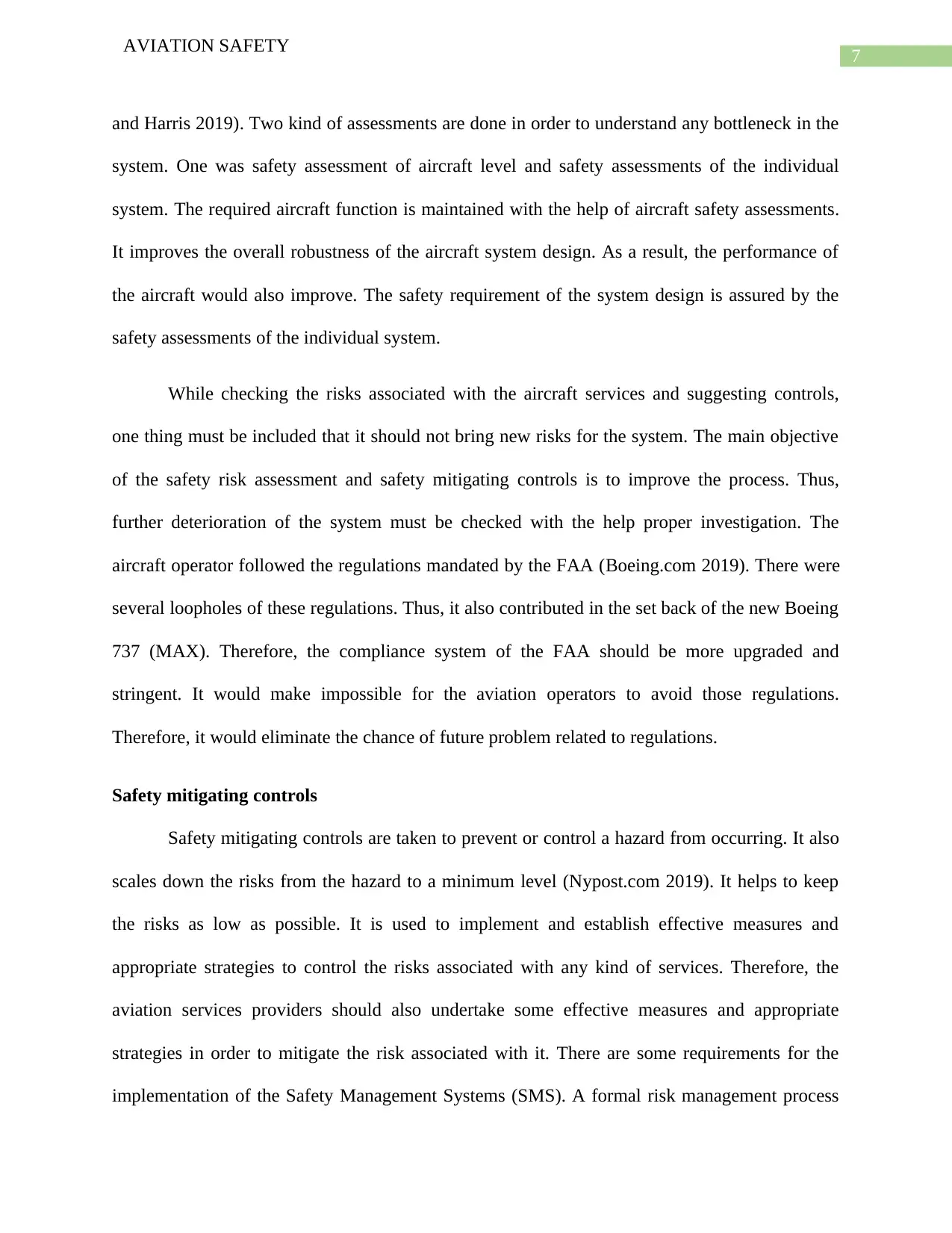
7
AVIATION SAFETY
and Harris 2019). Two kind of assessments are done in order to understand any bottleneck in the
system. One was safety assessment of aircraft level and safety assessments of the individual
system. The required aircraft function is maintained with the help of aircraft safety assessments.
It improves the overall robustness of the aircraft system design. As a result, the performance of
the aircraft would also improve. The safety requirement of the system design is assured by the
safety assessments of the individual system.
While checking the risks associated with the aircraft services and suggesting controls,
one thing must be included that it should not bring new risks for the system. The main objective
of the safety risk assessment and safety mitigating controls is to improve the process. Thus,
further deterioration of the system must be checked with the help proper investigation. The
aircraft operator followed the regulations mandated by the FAA (Boeing.com 2019). There were
several loopholes of these regulations. Thus, it also contributed in the set back of the new Boeing
737 (MAX). Therefore, the compliance system of the FAA should be more upgraded and
stringent. It would make impossible for the aviation operators to avoid those regulations.
Therefore, it would eliminate the chance of future problem related to regulations.
Safety mitigating controls
Safety mitigating controls are taken to prevent or control a hazard from occurring. It also
scales down the risks from the hazard to a minimum level (Nypost.com 2019). It helps to keep
the risks as low as possible. It is used to implement and establish effective measures and
appropriate strategies to control the risks associated with any kind of services. Therefore, the
aviation services providers should also undertake some effective measures and appropriate
strategies in order to mitigate the risk associated with it. There are some requirements for the
implementation of the Safety Management Systems (SMS). A formal risk management process
AVIATION SAFETY
and Harris 2019). Two kind of assessments are done in order to understand any bottleneck in the
system. One was safety assessment of aircraft level and safety assessments of the individual
system. The required aircraft function is maintained with the help of aircraft safety assessments.
It improves the overall robustness of the aircraft system design. As a result, the performance of
the aircraft would also improve. The safety requirement of the system design is assured by the
safety assessments of the individual system.
While checking the risks associated with the aircraft services and suggesting controls,
one thing must be included that it should not bring new risks for the system. The main objective
of the safety risk assessment and safety mitigating controls is to improve the process. Thus,
further deterioration of the system must be checked with the help proper investigation. The
aircraft operator followed the regulations mandated by the FAA (Boeing.com 2019). There were
several loopholes of these regulations. Thus, it also contributed in the set back of the new Boeing
737 (MAX). Therefore, the compliance system of the FAA should be more upgraded and
stringent. It would make impossible for the aviation operators to avoid those regulations.
Therefore, it would eliminate the chance of future problem related to regulations.
Safety mitigating controls
Safety mitigating controls are taken to prevent or control a hazard from occurring. It also
scales down the risks from the hazard to a minimum level (Nypost.com 2019). It helps to keep
the risks as low as possible. It is used to implement and establish effective measures and
appropriate strategies to control the risks associated with any kind of services. Therefore, the
aviation services providers should also undertake some effective measures and appropriate
strategies in order to mitigate the risk associated with it. There are some requirements for the
implementation of the Safety Management Systems (SMS). A formal risk management process
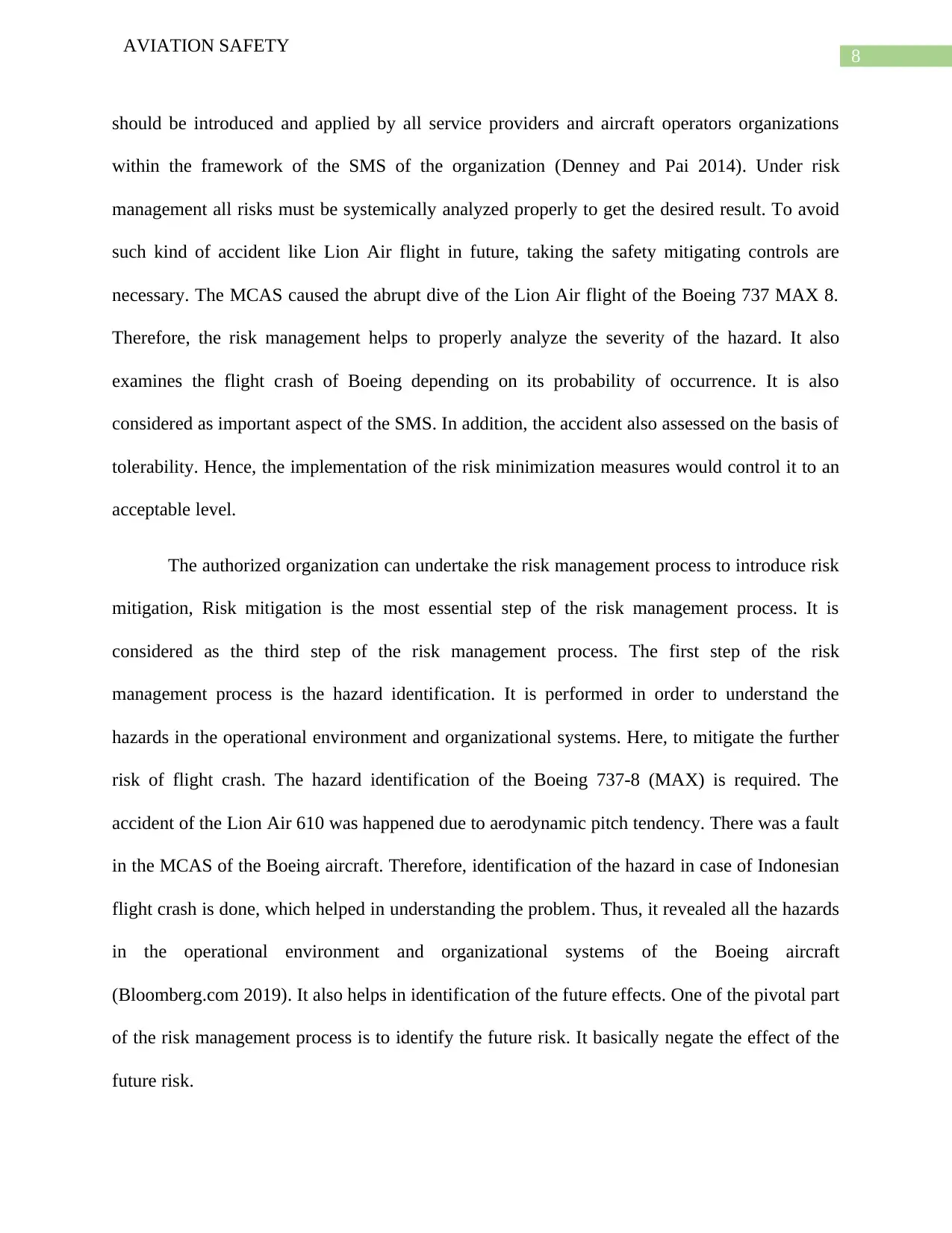
8
AVIATION SAFETY
should be introduced and applied by all service providers and aircraft operators organizations
within the framework of the SMS of the organization (Denney and Pai 2014). Under risk
management all risks must be systemically analyzed properly to get the desired result. To avoid
such kind of accident like Lion Air flight in future, taking the safety mitigating controls are
necessary. The MCAS caused the abrupt dive of the Lion Air flight of the Boeing 737 MAX 8.
Therefore, the risk management helps to properly analyze the severity of the hazard. It also
examines the flight crash of Boeing depending on its probability of occurrence. It is also
considered as important aspect of the SMS. In addition, the accident also assessed on the basis of
tolerability. Hence, the implementation of the risk minimization measures would control it to an
acceptable level.
The authorized organization can undertake the risk management process to introduce risk
mitigation, Risk mitigation is the most essential step of the risk management process. It is
considered as the third step of the risk management process. The first step of the risk
management process is the hazard identification. It is performed in order to understand the
hazards in the operational environment and organizational systems. Here, to mitigate the further
risk of flight crash. The hazard identification of the Boeing 737-8 (MAX) is required. The
accident of the Lion Air 610 was happened due to aerodynamic pitch tendency. There was a fault
in the MCAS of the Boeing aircraft. Therefore, identification of the hazard in case of Indonesian
flight crash is done, which helped in understanding the problem. Thus, it revealed all the hazards
in the operational environment and organizational systems of the Boeing aircraft
(Bloomberg.com 2019). It also helps in identification of the future effects. One of the pivotal part
of the risk management process is to identify the future risk. It basically negate the effect of the
future risk.
AVIATION SAFETY
should be introduced and applied by all service providers and aircraft operators organizations
within the framework of the SMS of the organization (Denney and Pai 2014). Under risk
management all risks must be systemically analyzed properly to get the desired result. To avoid
such kind of accident like Lion Air flight in future, taking the safety mitigating controls are
necessary. The MCAS caused the abrupt dive of the Lion Air flight of the Boeing 737 MAX 8.
Therefore, the risk management helps to properly analyze the severity of the hazard. It also
examines the flight crash of Boeing depending on its probability of occurrence. It is also
considered as important aspect of the SMS. In addition, the accident also assessed on the basis of
tolerability. Hence, the implementation of the risk minimization measures would control it to an
acceptable level.
The authorized organization can undertake the risk management process to introduce risk
mitigation, Risk mitigation is the most essential step of the risk management process. It is
considered as the third step of the risk management process. The first step of the risk
management process is the hazard identification. It is performed in order to understand the
hazards in the operational environment and organizational systems. Here, to mitigate the further
risk of flight crash. The hazard identification of the Boeing 737-8 (MAX) is required. The
accident of the Lion Air 610 was happened due to aerodynamic pitch tendency. There was a fault
in the MCAS of the Boeing aircraft. Therefore, identification of the hazard in case of Indonesian
flight crash is done, which helped in understanding the problem. Thus, it revealed all the hazards
in the operational environment and organizational systems of the Boeing aircraft
(Bloomberg.com 2019). It also helps in identification of the future effects. One of the pivotal part
of the risk management process is to identify the future risk. It basically negate the effect of the
future risk.
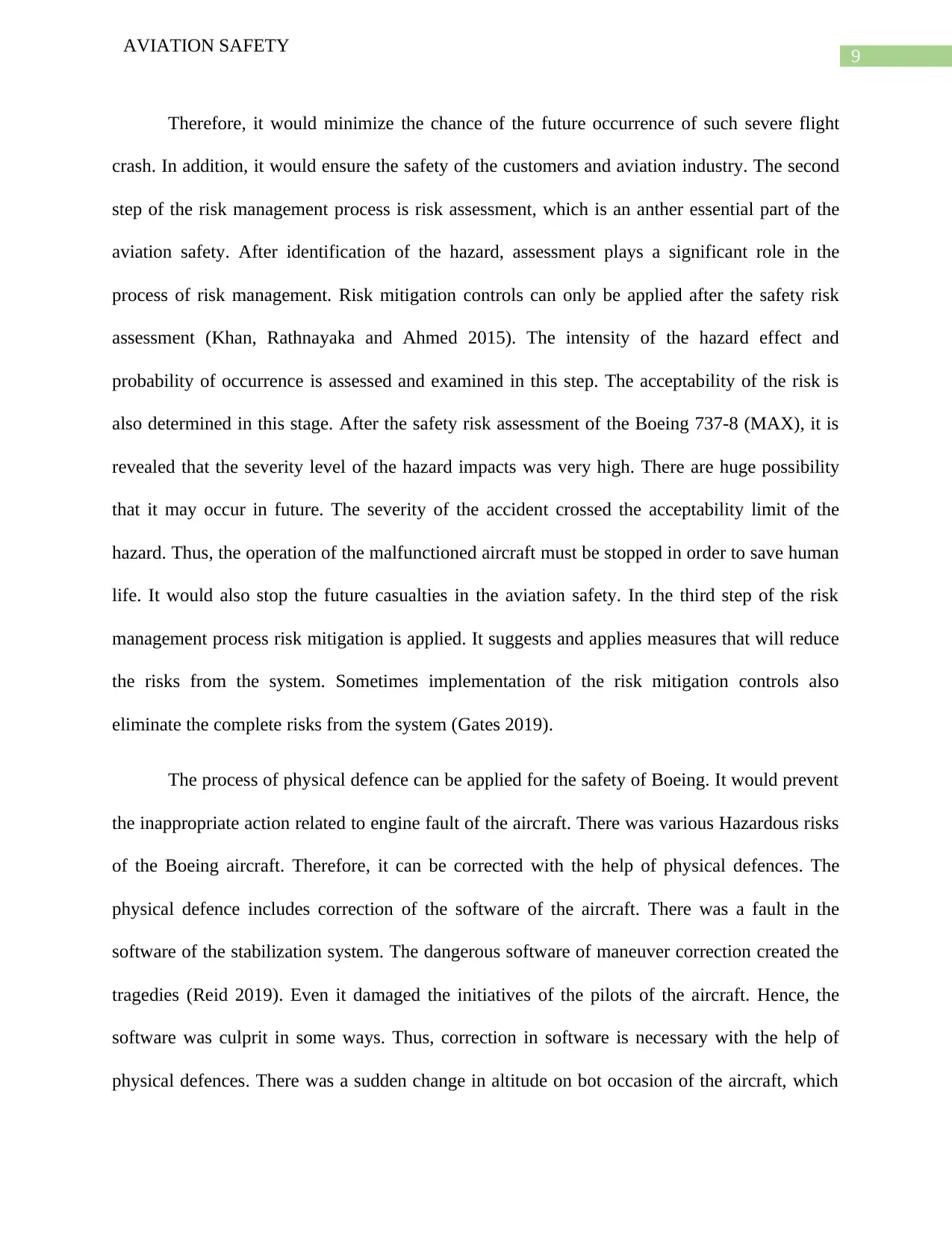
9
AVIATION SAFETY
Therefore, it would minimize the chance of the future occurrence of such severe flight
crash. In addition, it would ensure the safety of the customers and aviation industry. The second
step of the risk management process is risk assessment, which is an anther essential part of the
aviation safety. After identification of the hazard, assessment plays a significant role in the
process of risk management. Risk mitigation controls can only be applied after the safety risk
assessment (Khan, Rathnayaka and Ahmed 2015). The intensity of the hazard effect and
probability of occurrence is assessed and examined in this step. The acceptability of the risk is
also determined in this stage. After the safety risk assessment of the Boeing 737-8 (MAX), it is
revealed that the severity level of the hazard impacts was very high. There are huge possibility
that it may occur in future. The severity of the accident crossed the acceptability limit of the
hazard. Thus, the operation of the malfunctioned aircraft must be stopped in order to save human
life. It would also stop the future casualties in the aviation safety. In the third step of the risk
management process risk mitigation is applied. It suggests and applies measures that will reduce
the risks from the system. Sometimes implementation of the risk mitigation controls also
eliminate the complete risks from the system (Gates 2019).
The process of physical defence can be applied for the safety of Boeing. It would prevent
the inappropriate action related to engine fault of the aircraft. There was various Hazardous risks
of the Boeing aircraft. Therefore, it can be corrected with the help of physical defences. The
physical defence includes correction of the software of the aircraft. There was a fault in the
software of the stabilization system. The dangerous software of maneuver correction created the
tragedies (Reid 2019). Even it damaged the initiatives of the pilots of the aircraft. Hence, the
software was culprit in some ways. Thus, correction in software is necessary with the help of
physical defences. There was a sudden change in altitude on bot occasion of the aircraft, which
AVIATION SAFETY
Therefore, it would minimize the chance of the future occurrence of such severe flight
crash. In addition, it would ensure the safety of the customers and aviation industry. The second
step of the risk management process is risk assessment, which is an anther essential part of the
aviation safety. After identification of the hazard, assessment plays a significant role in the
process of risk management. Risk mitigation controls can only be applied after the safety risk
assessment (Khan, Rathnayaka and Ahmed 2015). The intensity of the hazard effect and
probability of occurrence is assessed and examined in this step. The acceptability of the risk is
also determined in this stage. After the safety risk assessment of the Boeing 737-8 (MAX), it is
revealed that the severity level of the hazard impacts was very high. There are huge possibility
that it may occur in future. The severity of the accident crossed the acceptability limit of the
hazard. Thus, the operation of the malfunctioned aircraft must be stopped in order to save human
life. It would also stop the future casualties in the aviation safety. In the third step of the risk
management process risk mitigation is applied. It suggests and applies measures that will reduce
the risks from the system. Sometimes implementation of the risk mitigation controls also
eliminate the complete risks from the system (Gates 2019).
The process of physical defence can be applied for the safety of Boeing. It would prevent
the inappropriate action related to engine fault of the aircraft. There was various Hazardous risks
of the Boeing aircraft. Therefore, it can be corrected with the help of physical defences. The
physical defence includes correction of the software of the aircraft. There was a fault in the
software of the stabilization system. The dangerous software of maneuver correction created the
tragedies (Reid 2019). Even it damaged the initiatives of the pilots of the aircraft. Hence, the
software was culprit in some ways. Thus, correction in software is necessary with the help of
physical defences. There was a sudden change in altitude on bot occasion of the aircraft, which
Secure Best Marks with AI Grader
Need help grading? Try our AI Grader for instant feedback on your assignments.
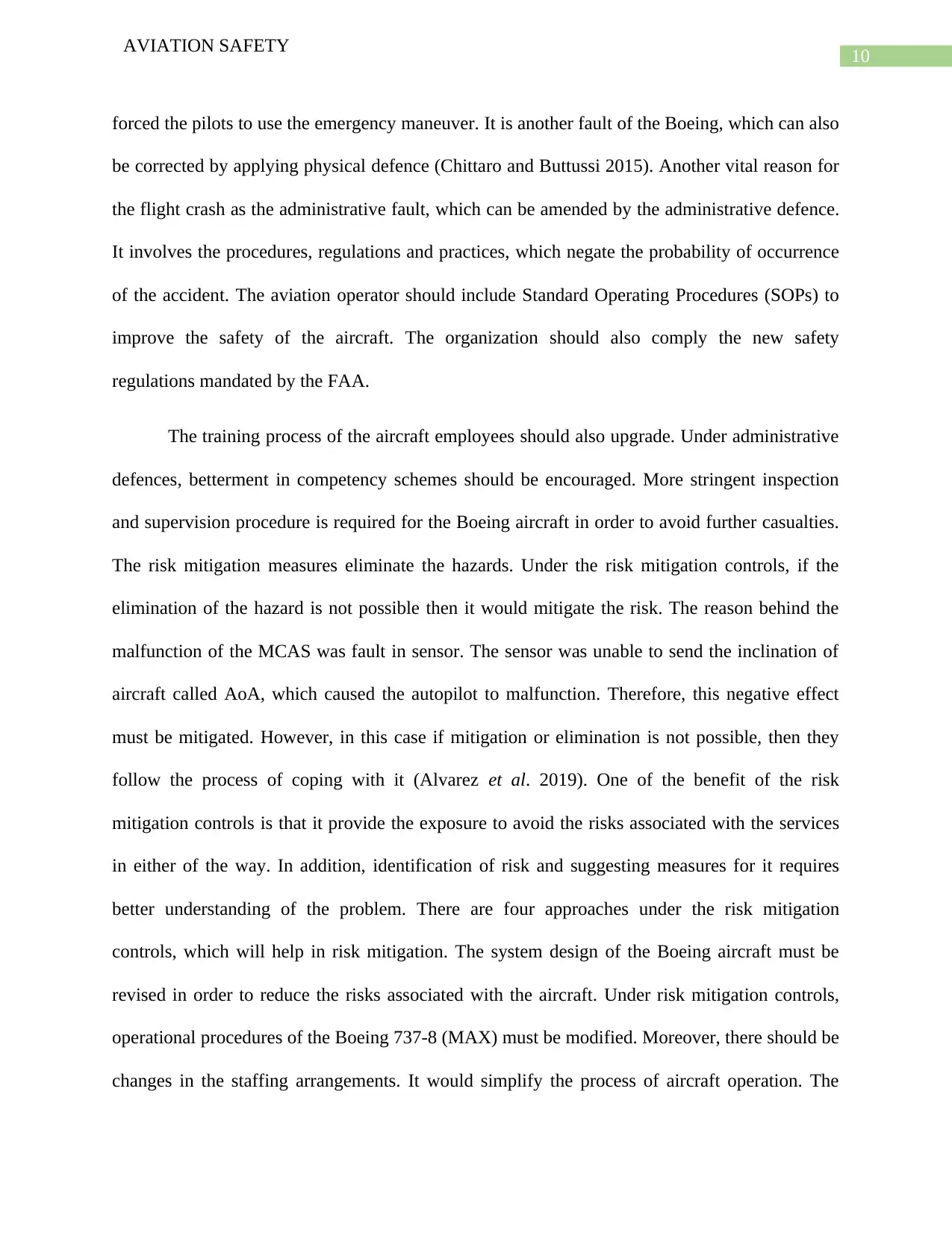
10
AVIATION SAFETY
forced the pilots to use the emergency maneuver. It is another fault of the Boeing, which can also
be corrected by applying physical defence (Chittaro and Buttussi 2015). Another vital reason for
the flight crash as the administrative fault, which can be amended by the administrative defence.
It involves the procedures, regulations and practices, which negate the probability of occurrence
of the accident. The aviation operator should include Standard Operating Procedures (SOPs) to
improve the safety of the aircraft. The organization should also comply the new safety
regulations mandated by the FAA.
The training process of the aircraft employees should also upgrade. Under administrative
defences, betterment in competency schemes should be encouraged. More stringent inspection
and supervision procedure is required for the Boeing aircraft in order to avoid further casualties.
The risk mitigation measures eliminate the hazards. Under the risk mitigation controls, if the
elimination of the hazard is not possible then it would mitigate the risk. The reason behind the
malfunction of the MCAS was fault in sensor. The sensor was unable to send the inclination of
aircraft called AoA, which caused the autopilot to malfunction. Therefore, this negative effect
must be mitigated. However, in this case if mitigation or elimination is not possible, then they
follow the process of coping with it (Alvarez et al. 2019). One of the benefit of the risk
mitigation controls is that it provide the exposure to avoid the risks associated with the services
in either of the way. In addition, identification of risk and suggesting measures for it requires
better understanding of the problem. There are four approaches under the risk mitigation
controls, which will help in risk mitigation. The system design of the Boeing aircraft must be
revised in order to reduce the risks associated with the aircraft. Under risk mitigation controls,
operational procedures of the Boeing 737-8 (MAX) must be modified. Moreover, there should be
changes in the staffing arrangements. It would simplify the process of aircraft operation. The
AVIATION SAFETY
forced the pilots to use the emergency maneuver. It is another fault of the Boeing, which can also
be corrected by applying physical defence (Chittaro and Buttussi 2015). Another vital reason for
the flight crash as the administrative fault, which can be amended by the administrative defence.
It involves the procedures, regulations and practices, which negate the probability of occurrence
of the accident. The aviation operator should include Standard Operating Procedures (SOPs) to
improve the safety of the aircraft. The organization should also comply the new safety
regulations mandated by the FAA.
The training process of the aircraft employees should also upgrade. Under administrative
defences, betterment in competency schemes should be encouraged. More stringent inspection
and supervision procedure is required for the Boeing aircraft in order to avoid further casualties.
The risk mitigation measures eliminate the hazards. Under the risk mitigation controls, if the
elimination of the hazard is not possible then it would mitigate the risk. The reason behind the
malfunction of the MCAS was fault in sensor. The sensor was unable to send the inclination of
aircraft called AoA, which caused the autopilot to malfunction. Therefore, this negative effect
must be mitigated. However, in this case if mitigation or elimination is not possible, then they
follow the process of coping with it (Alvarez et al. 2019). One of the benefit of the risk
mitigation controls is that it provide the exposure to avoid the risks associated with the services
in either of the way. In addition, identification of risk and suggesting measures for it requires
better understanding of the problem. There are four approaches under the risk mitigation
controls, which will help in risk mitigation. The system design of the Boeing aircraft must be
revised in order to reduce the risks associated with the aircraft. Under risk mitigation controls,
operational procedures of the Boeing 737-8 (MAX) must be modified. Moreover, there should be
changes in the staffing arrangements. It would simplify the process of aircraft operation. The
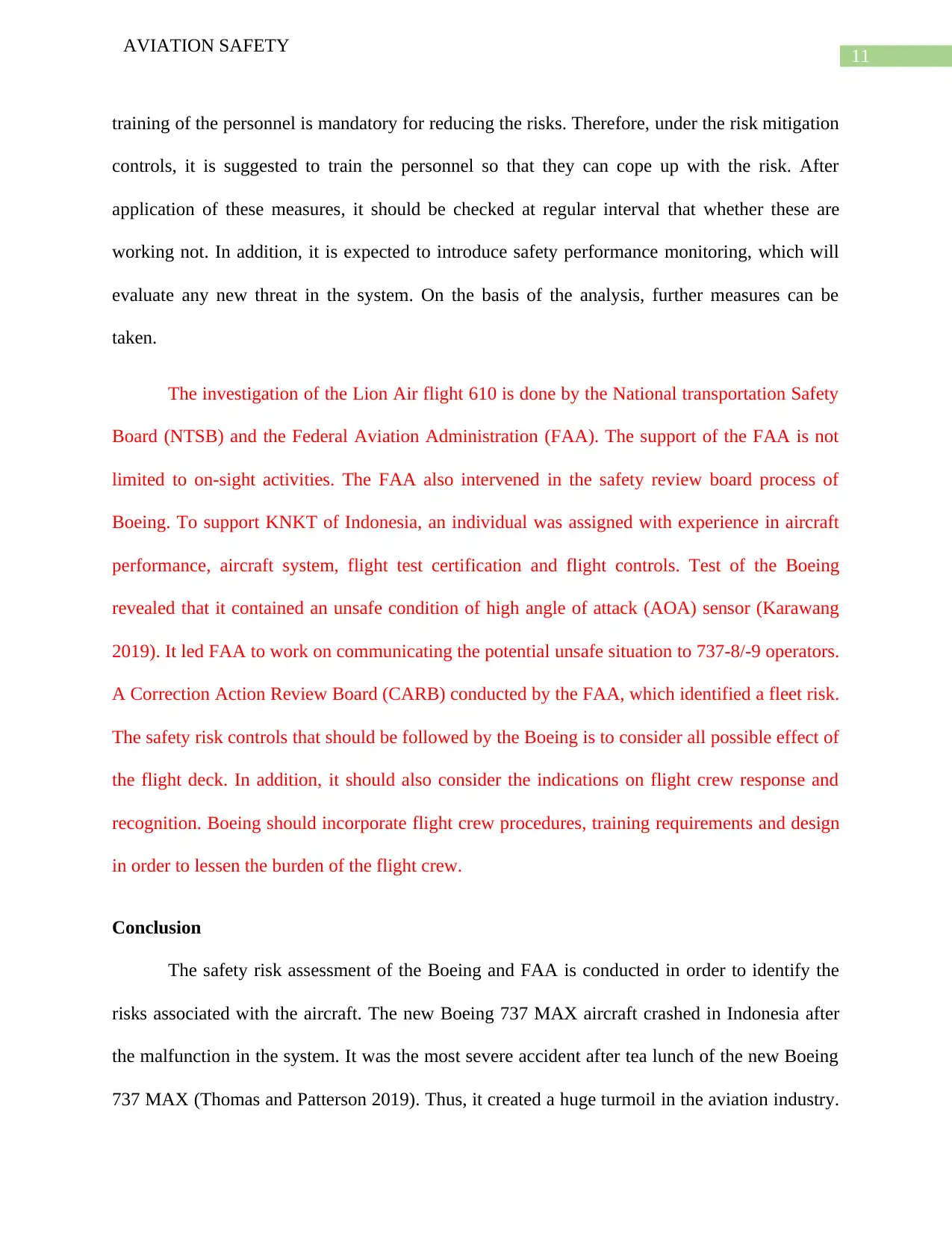
11
AVIATION SAFETY
training of the personnel is mandatory for reducing the risks. Therefore, under the risk mitigation
controls, it is suggested to train the personnel so that they can cope up with the risk. After
application of these measures, it should be checked at regular interval that whether these are
working not. In addition, it is expected to introduce safety performance monitoring, which will
evaluate any new threat in the system. On the basis of the analysis, further measures can be
taken.
The investigation of the Lion Air flight 610 is done by the National transportation Safety
Board (NTSB) and the Federal Aviation Administration (FAA). The support of the FAA is not
limited to on-sight activities. The FAA also intervened in the safety review board process of
Boeing. To support KNKT of Indonesia, an individual was assigned with experience in aircraft
performance, aircraft system, flight test certification and flight controls. Test of the Boeing
revealed that it contained an unsafe condition of high angle of attack (AOA) sensor (Karawang
2019). It led FAA to work on communicating the potential unsafe situation to 737-8/-9 operators.
A Correction Action Review Board (CARB) conducted by the FAA, which identified a fleet risk.
The safety risk controls that should be followed by the Boeing is to consider all possible effect of
the flight deck. In addition, it should also consider the indications on flight crew response and
recognition. Boeing should incorporate flight crew procedures, training requirements and design
in order to lessen the burden of the flight crew.
Conclusion
The safety risk assessment of the Boeing and FAA is conducted in order to identify the
risks associated with the aircraft. The new Boeing 737 MAX aircraft crashed in Indonesia after
the malfunction in the system. It was the most severe accident after tea lunch of the new Boeing
737 MAX (Thomas and Patterson 2019). Thus, it created a huge turmoil in the aviation industry.
AVIATION SAFETY
training of the personnel is mandatory for reducing the risks. Therefore, under the risk mitigation
controls, it is suggested to train the personnel so that they can cope up with the risk. After
application of these measures, it should be checked at regular interval that whether these are
working not. In addition, it is expected to introduce safety performance monitoring, which will
evaluate any new threat in the system. On the basis of the analysis, further measures can be
taken.
The investigation of the Lion Air flight 610 is done by the National transportation Safety
Board (NTSB) and the Federal Aviation Administration (FAA). The support of the FAA is not
limited to on-sight activities. The FAA also intervened in the safety review board process of
Boeing. To support KNKT of Indonesia, an individual was assigned with experience in aircraft
performance, aircraft system, flight test certification and flight controls. Test of the Boeing
revealed that it contained an unsafe condition of high angle of attack (AOA) sensor (Karawang
2019). It led FAA to work on communicating the potential unsafe situation to 737-8/-9 operators.
A Correction Action Review Board (CARB) conducted by the FAA, which identified a fleet risk.
The safety risk controls that should be followed by the Boeing is to consider all possible effect of
the flight deck. In addition, it should also consider the indications on flight crew response and
recognition. Boeing should incorporate flight crew procedures, training requirements and design
in order to lessen the burden of the flight crew.
Conclusion
The safety risk assessment of the Boeing and FAA is conducted in order to identify the
risks associated with the aircraft. The new Boeing 737 MAX aircraft crashed in Indonesia after
the malfunction in the system. It was the most severe accident after tea lunch of the new Boeing
737 MAX (Thomas and Patterson 2019). Thus, it created a huge turmoil in the aviation industry.
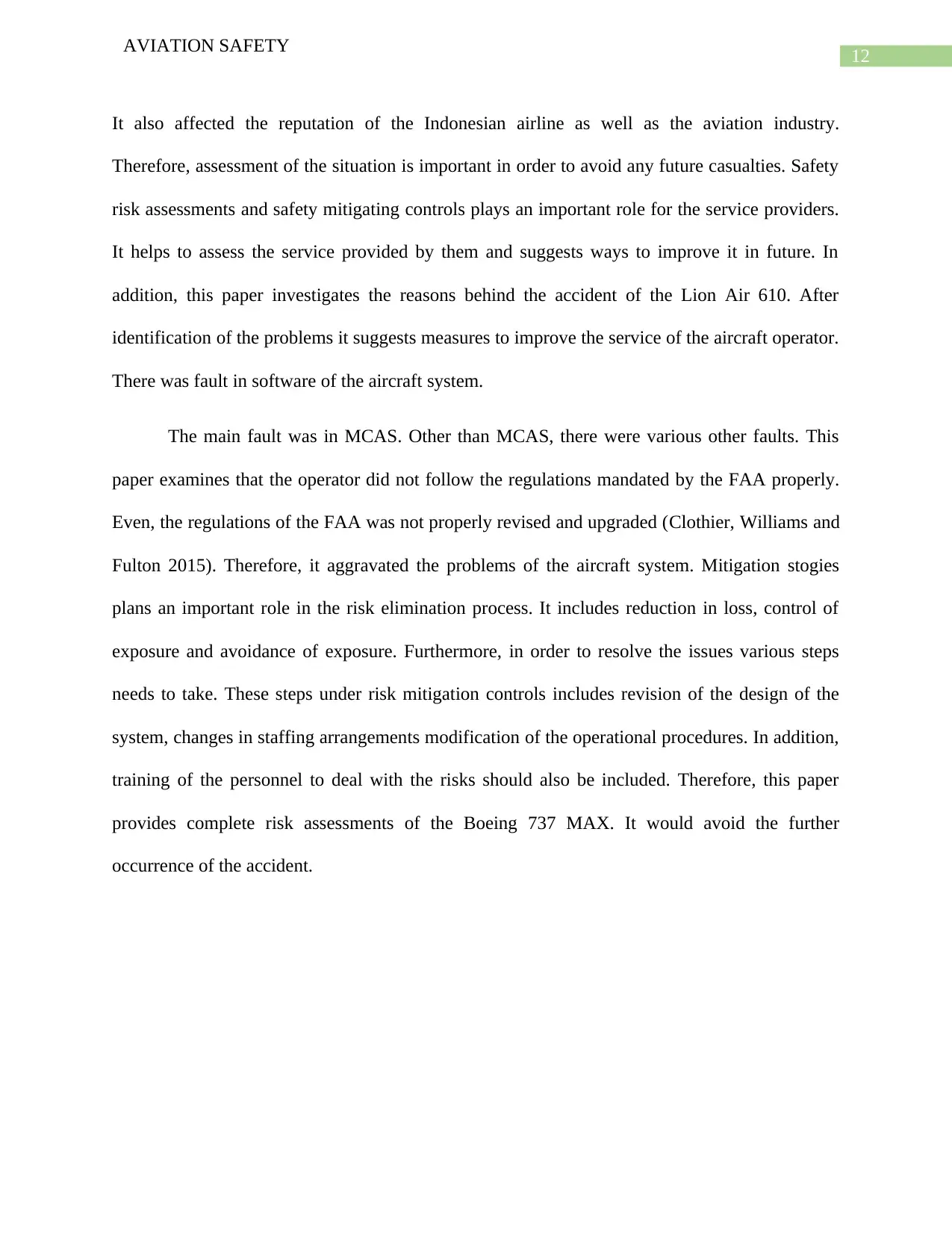
12
AVIATION SAFETY
It also affected the reputation of the Indonesian airline as well as the aviation industry.
Therefore, assessment of the situation is important in order to avoid any future casualties. Safety
risk assessments and safety mitigating controls plays an important role for the service providers.
It helps to assess the service provided by them and suggests ways to improve it in future. In
addition, this paper investigates the reasons behind the accident of the Lion Air 610. After
identification of the problems it suggests measures to improve the service of the aircraft operator.
There was fault in software of the aircraft system.
The main fault was in MCAS. Other than MCAS, there were various other faults. This
paper examines that the operator did not follow the regulations mandated by the FAA properly.
Even, the regulations of the FAA was not properly revised and upgraded (Clothier, Williams and
Fulton 2015). Therefore, it aggravated the problems of the aircraft system. Mitigation stogies
plans an important role in the risk elimination process. It includes reduction in loss, control of
exposure and avoidance of exposure. Furthermore, in order to resolve the issues various steps
needs to take. These steps under risk mitigation controls includes revision of the design of the
system, changes in staffing arrangements modification of the operational procedures. In addition,
training of the personnel to deal with the risks should also be included. Therefore, this paper
provides complete risk assessments of the Boeing 737 MAX. It would avoid the further
occurrence of the accident.
AVIATION SAFETY
It also affected the reputation of the Indonesian airline as well as the aviation industry.
Therefore, assessment of the situation is important in order to avoid any future casualties. Safety
risk assessments and safety mitigating controls plays an important role for the service providers.
It helps to assess the service provided by them and suggests ways to improve it in future. In
addition, this paper investigates the reasons behind the accident of the Lion Air 610. After
identification of the problems it suggests measures to improve the service of the aircraft operator.
There was fault in software of the aircraft system.
The main fault was in MCAS. Other than MCAS, there were various other faults. This
paper examines that the operator did not follow the regulations mandated by the FAA properly.
Even, the regulations of the FAA was not properly revised and upgraded (Clothier, Williams and
Fulton 2015). Therefore, it aggravated the problems of the aircraft system. Mitigation stogies
plans an important role in the risk elimination process. It includes reduction in loss, control of
exposure and avoidance of exposure. Furthermore, in order to resolve the issues various steps
needs to take. These steps under risk mitigation controls includes revision of the design of the
system, changes in staffing arrangements modification of the operational procedures. In addition,
training of the personnel to deal with the risks should also be included. Therefore, this paper
provides complete risk assessments of the Boeing 737 MAX. It would avoid the further
occurrence of the accident.
Paraphrase This Document
Need a fresh take? Get an instant paraphrase of this document with our AI Paraphraser
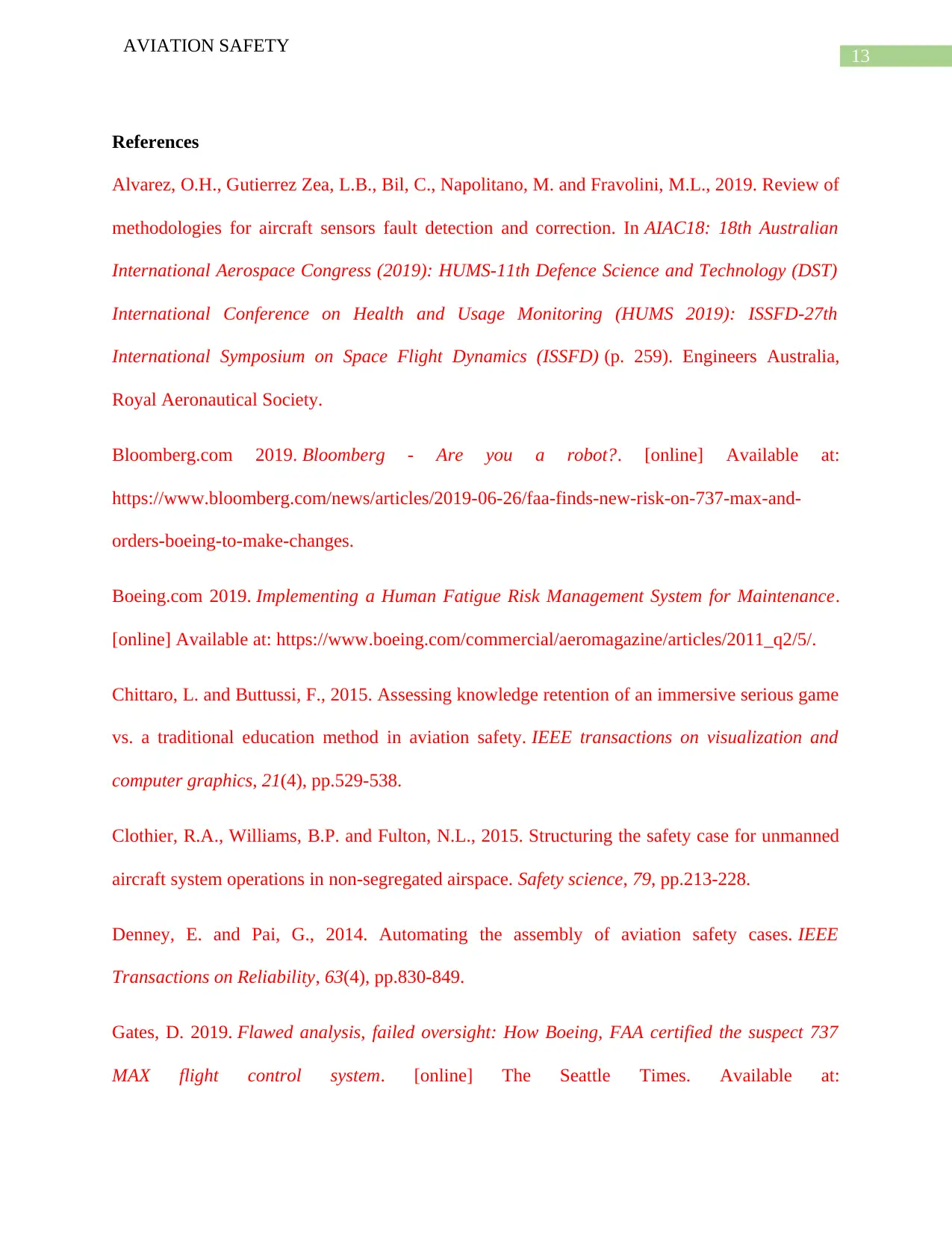
13
AVIATION SAFETY
References
Alvarez, O.H., Gutierrez Zea, L.B., Bil, C., Napolitano, M. and Fravolini, M.L., 2019. Review of
methodologies for aircraft sensors fault detection and correction. In AIAC18: 18th Australian
International Aerospace Congress (2019): HUMS-11th Defence Science and Technology (DST)
International Conference on Health and Usage Monitoring (HUMS 2019): ISSFD-27th
International Symposium on Space Flight Dynamics (ISSFD) (p. 259). Engineers Australia,
Royal Aeronautical Society.
Bloomberg.com 2019. Bloomberg - Are you a robot?. [online] Available at:
https://www.bloomberg.com/news/articles/2019-06-26/faa-finds-new-risk-on-737-max-and-
orders-boeing-to-make-changes.
Boeing.com 2019. Implementing a Human Fatigue Risk Management System for Maintenance.
[online] Available at: https://www.boeing.com/commercial/aeromagazine/articles/2011_q2/5/.
Chittaro, L. and Buttussi, F., 2015. Assessing knowledge retention of an immersive serious game
vs. a traditional education method in aviation safety. IEEE transactions on visualization and
computer graphics, 21(4), pp.529-538.
Clothier, R.A., Williams, B.P. and Fulton, N.L., 2015. Structuring the safety case for unmanned
aircraft system operations in non-segregated airspace. Safety science, 79, pp.213-228.
Denney, E. and Pai, G., 2014. Automating the assembly of aviation safety cases. IEEE
Transactions on Reliability, 63(4), pp.830-849.
Gates, D. 2019. Flawed analysis, failed oversight: How Boeing, FAA certified the suspect 737
MAX flight control system. [online] The Seattle Times. Available at:
AVIATION SAFETY
References
Alvarez, O.H., Gutierrez Zea, L.B., Bil, C., Napolitano, M. and Fravolini, M.L., 2019. Review of
methodologies for aircraft sensors fault detection and correction. In AIAC18: 18th Australian
International Aerospace Congress (2019): HUMS-11th Defence Science and Technology (DST)
International Conference on Health and Usage Monitoring (HUMS 2019): ISSFD-27th
International Symposium on Space Flight Dynamics (ISSFD) (p. 259). Engineers Australia,
Royal Aeronautical Society.
Bloomberg.com 2019. Bloomberg - Are you a robot?. [online] Available at:
https://www.bloomberg.com/news/articles/2019-06-26/faa-finds-new-risk-on-737-max-and-
orders-boeing-to-make-changes.
Boeing.com 2019. Implementing a Human Fatigue Risk Management System for Maintenance.
[online] Available at: https://www.boeing.com/commercial/aeromagazine/articles/2011_q2/5/.
Chittaro, L. and Buttussi, F., 2015. Assessing knowledge retention of an immersive serious game
vs. a traditional education method in aviation safety. IEEE transactions on visualization and
computer graphics, 21(4), pp.529-538.
Clothier, R.A., Williams, B.P. and Fulton, N.L., 2015. Structuring the safety case for unmanned
aircraft system operations in non-segregated airspace. Safety science, 79, pp.213-228.
Denney, E. and Pai, G., 2014. Automating the assembly of aviation safety cases. IEEE
Transactions on Reliability, 63(4), pp.830-849.
Gates, D. 2019. Flawed analysis, failed oversight: How Boeing, FAA certified the suspect 737
MAX flight control system. [online] The Seattle Times. Available at:
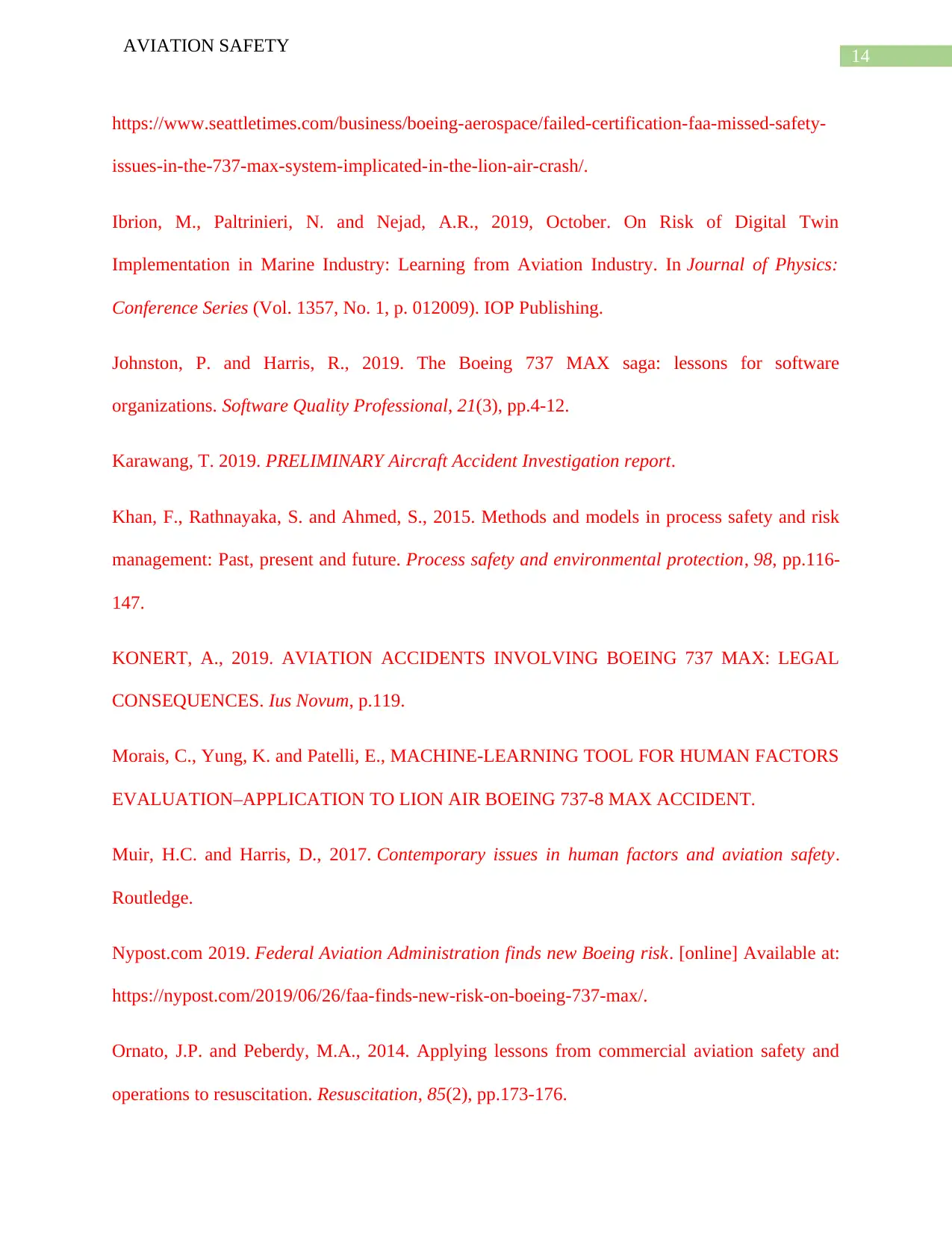
14
AVIATION SAFETY
https://www.seattletimes.com/business/boeing-aerospace/failed-certification-faa-missed-safety-
issues-in-the-737-max-system-implicated-in-the-lion-air-crash/.
Ibrion, M., Paltrinieri, N. and Nejad, A.R., 2019, October. On Risk of Digital Twin
Implementation in Marine Industry: Learning from Aviation Industry. In Journal of Physics:
Conference Series (Vol. 1357, No. 1, p. 012009). IOP Publishing.
Johnston, P. and Harris, R., 2019. The Boeing 737 MAX saga: lessons for software
organizations. Software Quality Professional, 21(3), pp.4-12.
Karawang, T. 2019. PRELIMINARY Aircraft Accident Investigation report.
Khan, F., Rathnayaka, S. and Ahmed, S., 2015. Methods and models in process safety and risk
management: Past, present and future. Process safety and environmental protection, 98, pp.116-
147.
KONERT, A., 2019. AVIATION ACCIDENTS INVOLVING BOEING 737 MAX: LEGAL
CONSEQUENCES. Ius Novum, p.119.
Morais, C., Yung, K. and Patelli, E., MACHINE-LEARNING TOOL FOR HUMAN FACTORS
EVALUATION–APPLICATION TO LION AIR BOEING 737-8 MAX ACCIDENT.
Muir, H.C. and Harris, D., 2017. Contemporary issues in human factors and aviation safety.
Routledge.
Nypost.com 2019. Federal Aviation Administration finds new Boeing risk. [online] Available at:
https://nypost.com/2019/06/26/faa-finds-new-risk-on-boeing-737-max/.
Ornato, J.P. and Peberdy, M.A., 2014. Applying lessons from commercial aviation safety and
operations to resuscitation. Resuscitation, 85(2), pp.173-176.
AVIATION SAFETY
https://www.seattletimes.com/business/boeing-aerospace/failed-certification-faa-missed-safety-
issues-in-the-737-max-system-implicated-in-the-lion-air-crash/.
Ibrion, M., Paltrinieri, N. and Nejad, A.R., 2019, October. On Risk of Digital Twin
Implementation in Marine Industry: Learning from Aviation Industry. In Journal of Physics:
Conference Series (Vol. 1357, No. 1, p. 012009). IOP Publishing.
Johnston, P. and Harris, R., 2019. The Boeing 737 MAX saga: lessons for software
organizations. Software Quality Professional, 21(3), pp.4-12.
Karawang, T. 2019. PRELIMINARY Aircraft Accident Investigation report.
Khan, F., Rathnayaka, S. and Ahmed, S., 2015. Methods and models in process safety and risk
management: Past, present and future. Process safety and environmental protection, 98, pp.116-
147.
KONERT, A., 2019. AVIATION ACCIDENTS INVOLVING BOEING 737 MAX: LEGAL
CONSEQUENCES. Ius Novum, p.119.
Morais, C., Yung, K. and Patelli, E., MACHINE-LEARNING TOOL FOR HUMAN FACTORS
EVALUATION–APPLICATION TO LION AIR BOEING 737-8 MAX ACCIDENT.
Muir, H.C. and Harris, D., 2017. Contemporary issues in human factors and aviation safety.
Routledge.
Nypost.com 2019. Federal Aviation Administration finds new Boeing risk. [online] Available at:
https://nypost.com/2019/06/26/faa-finds-new-risk-on-boeing-737-max/.
Ornato, J.P. and Peberdy, M.A., 2014. Applying lessons from commercial aviation safety and
operations to resuscitation. Resuscitation, 85(2), pp.173-176.
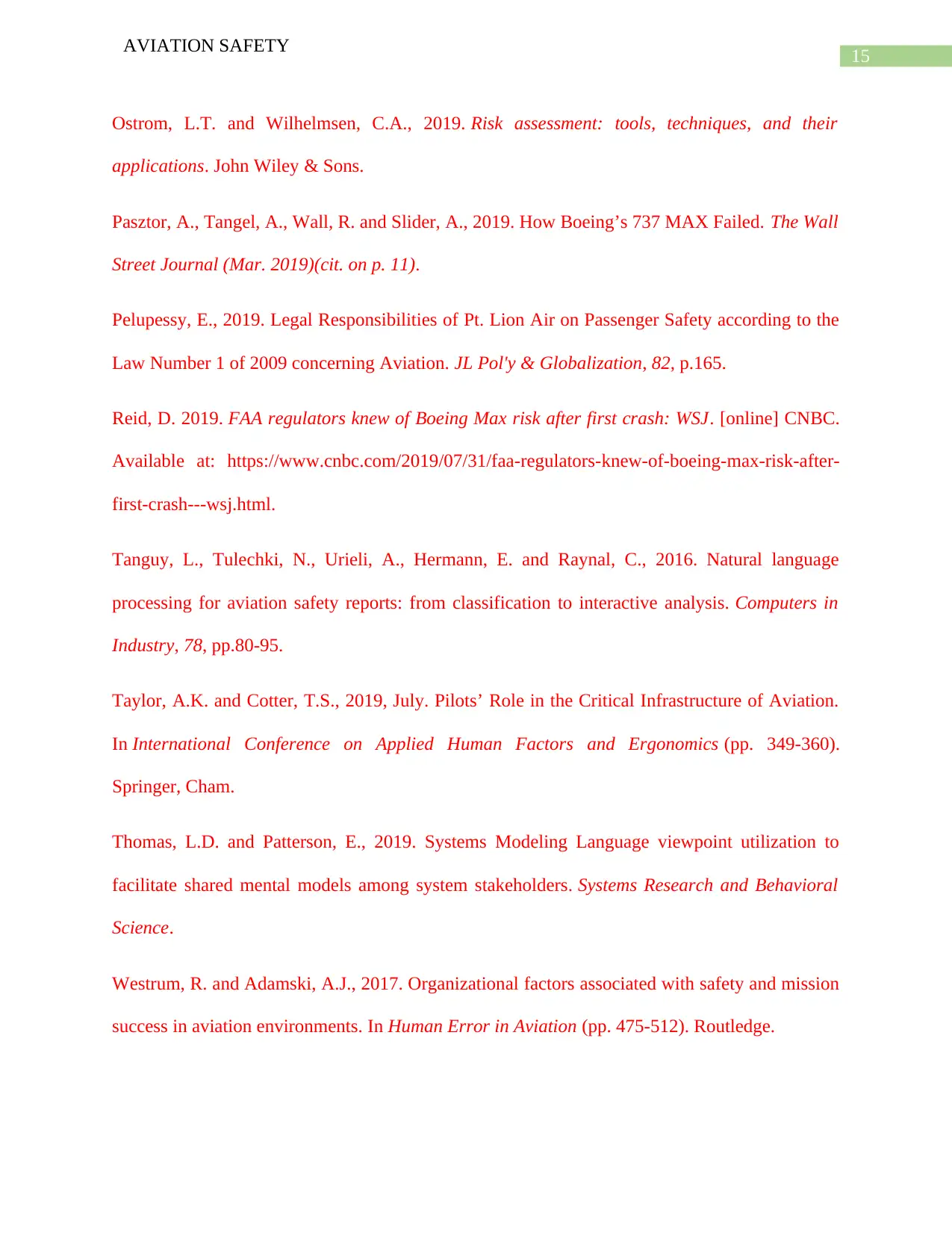
15
AVIATION SAFETY
Ostrom, L.T. and Wilhelmsen, C.A., 2019. Risk assessment: tools, techniques, and their
applications. John Wiley & Sons.
Pasztor, A., Tangel, A., Wall, R. and Slider, A., 2019. How Boeing’s 737 MAX Failed. The Wall
Street Journal (Mar. 2019)(cit. on p. 11).
Pelupessy, E., 2019. Legal Responsibilities of Pt. Lion Air on Passenger Safety according to the
Law Number 1 of 2009 concerning Aviation. JL Pol'y & Globalization, 82, p.165.
Reid, D. 2019. FAA regulators knew of Boeing Max risk after first crash: WSJ. [online] CNBC.
Available at: https://www.cnbc.com/2019/07/31/faa-regulators-knew-of-boeing-max-risk-after-
first-crash---wsj.html.
Tanguy, L., Tulechki, N., Urieli, A., Hermann, E. and Raynal, C., 2016. Natural language
processing for aviation safety reports: from classification to interactive analysis. Computers in
Industry, 78, pp.80-95.
Taylor, A.K. and Cotter, T.S., 2019, July. Pilots’ Role in the Critical Infrastructure of Aviation.
In International Conference on Applied Human Factors and Ergonomics (pp. 349-360).
Springer, Cham.
Thomas, L.D. and Patterson, E., 2019. Systems Modeling Language viewpoint utilization to
facilitate shared mental models among system stakeholders. Systems Research and Behavioral
Science.
Westrum, R. and Adamski, A.J., 2017. Organizational factors associated with safety and mission
success in aviation environments. In Human Error in Aviation (pp. 475-512). Routledge.
AVIATION SAFETY
Ostrom, L.T. and Wilhelmsen, C.A., 2019. Risk assessment: tools, techniques, and their
applications. John Wiley & Sons.
Pasztor, A., Tangel, A., Wall, R. and Slider, A., 2019. How Boeing’s 737 MAX Failed. The Wall
Street Journal (Mar. 2019)(cit. on p. 11).
Pelupessy, E., 2019. Legal Responsibilities of Pt. Lion Air on Passenger Safety according to the
Law Number 1 of 2009 concerning Aviation. JL Pol'y & Globalization, 82, p.165.
Reid, D. 2019. FAA regulators knew of Boeing Max risk after first crash: WSJ. [online] CNBC.
Available at: https://www.cnbc.com/2019/07/31/faa-regulators-knew-of-boeing-max-risk-after-
first-crash---wsj.html.
Tanguy, L., Tulechki, N., Urieli, A., Hermann, E. and Raynal, C., 2016. Natural language
processing for aviation safety reports: from classification to interactive analysis. Computers in
Industry, 78, pp.80-95.
Taylor, A.K. and Cotter, T.S., 2019, July. Pilots’ Role in the Critical Infrastructure of Aviation.
In International Conference on Applied Human Factors and Ergonomics (pp. 349-360).
Springer, Cham.
Thomas, L.D. and Patterson, E., 2019. Systems Modeling Language viewpoint utilization to
facilitate shared mental models among system stakeholders. Systems Research and Behavioral
Science.
Westrum, R. and Adamski, A.J., 2017. Organizational factors associated with safety and mission
success in aviation environments. In Human Error in Aviation (pp. 475-512). Routledge.
1 out of 16
Related Documents
Your All-in-One AI-Powered Toolkit for Academic Success.
+13062052269
info@desklib.com
Available 24*7 on WhatsApp / Email
![[object Object]](/_next/static/media/star-bottom.7253800d.svg)
Unlock your academic potential
© 2024 | Zucol Services PVT LTD | All rights reserved.





